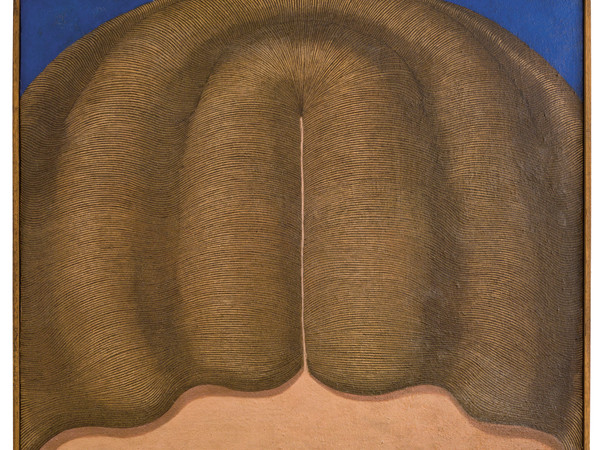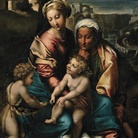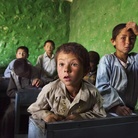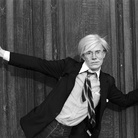Domenico Gnoli

Opera di Domenico Gnoli
From 28 Ottobre 2021 to 27 Febbraio 2022
Milan
Place: Fondazione Prada
Address: Largo Isarco 2
Times: Tuesday to Sunday 10am-07pm
Responsibles: Germano Celant
Ticket price: € 12
Telefono per informazioni: +39 02 56662611
E-Mail info: info@fondazioneprada.org
Official site: http://fondazioneprada.org
Fondazione Prada will present the exhibition “Domenico Gnoli” in Milan from 28 October 2021 to 27 February 2022.
This retrospective is part of the series of exhibitions that Fondazione Prada has dedicated to artists—such as Edward Kienholz, Leon Golub and William Copley—whose practice developed along paths and interests that took a different direction from the main artistic trends of the second half of the 20th century. The aim is to explore Gnoli’s practice and his activity as a unique discourse free of labels, documenting links with the international cultural scene of his time and highlighting affinities with contemporary visual research. Furthermore, “Domenico Gnoli” will expand on the insights of those who, in the past, interpreted the artist’s work from an original historical and critical viewpoint, recognizing the inspiration that he drew from the Renaissance and highlighting the narrative value of his works.
Conceived by Germano Celant, the exhibition brings together over 100 works produced by the artist between 1949 and 1969 and will be complemented by as many drawings. A chronological and documentary section featuring materials, photographs and other items will retrace the biography and artistic career of Domenico Gnoli (Rome, 1933 – New York, 1970) more than fifty years after his death. The project has been realized in collaboration with the artist’s Archives in Rome and Mallorca, which preserve Gnoli’s personal and professional heritage.
Grandson of Domenico Gnoli and son of Umberto Gnoli—both art critics and historians— Gnoli initially followed two directions: his work as a theater set designer, costume designer and illustrator, and his pictorial work. In 1955 his sets for William Shakespeare’s As You Like It at the Old Vic in London had a great success and made him known also in the United States. From 1959, he lived between Rome, New York, where he exhibited in several galleries and worked as an illustrator for magazines and publications, Paris and London before settling in 1963 in Deià on the island of Mallorca. In 1964, the year that Robert Rauschenberg achieved international recognition by winning the Golden Lion at the Venice Biennale, Gnoli took a linguistic leap that allowed his analytical painting to emerge alongside his accomplishments as a set designer and illustrator. In a letter the following year, the artist described this turning point in his career: “I have always worked [as a painter] as I do now, but it did not attract attention as it was abstraction’s moment. Only now, thanks to Pop Art, has my painting become comprehensible. [...] I always employ simple, given elements, I don’t want either to add or take anything away. I have never even wanted to deform; I isolate and represent. My themes come from the world around me, familiar situations, everyday life; because I never actively mediate against the object, I experience the magic of its presence.”
From that moment, his trajectory intersected the currents of minimalism, hyperrealism and Pop Art, even if, as the French writer André Pieyre de Mandiargues observed, “Gnoli’s manner of painting [...] illuminates as much as it describes the mundane objects by which man is surrounded. In the true sense of the word, it illustrates them, whereas the manner of pop artists popularizes them.” Gnoli also felt part of a “not eloquent” tradition of Italian painting developed by Masaccio and Piero della Francesca, and passed down via Piranesi, de Chirico, Carrà, Severini and Campigli. His work was also influenced by great contemporary artists like Bacon, Balthus, Dalí, Magritte, Shahn and Sutherland.
As Salvatore Settis explains, “To achieve perfect ineloquence, the impassiveness of things and the suspended magic of an impersonal reality, he had to turn his back on the tradition he loved so much and overturn its hierarchy of values. To deny ‘decoration’ by means of a new exploration of reality through detail.” Gnoli’s new line of research detached from the context and focused on details of human bodies or objects, accentuating their inherent sensuality and energy.
His precise painting of physical texture, one that brought out the surfaces, colors and substance of organic and inanimate elements, is also characterized by scrupulous photographic framing. It is a factual approach that “puts all things, natural and artificial, on the same plane, expressing an egalitarian desire, the revenge of insignificant and disqualified elements in the ranking of values: the low, the secondary, the auxiliary, the neglectable,” as Germano Celant observes. The unexpected appearance on the canvas of apparently incongruous elements, such as busts, locks of hair, shoes, armchairs, drawers, ties and buttons, gives the viewer a slight mental jolt. It is an invitation to fill out these mysterious images, a combination of reality and imagination, placed at the center of “a sensual and carnal theater where the continuing exchange between things and bodies is enacted, the protagonists of a total complicity.”
Created by the design studio 2x4 in New York, the two-floor exhibition setting inside the Podium harks back to 20th-century museum environments by tracing linear perspectives that divide the exhibition space into a series of monographic units. The artist’s works are arranged in themed series that reveal how each painting generated other works following a logical development of expression. Packed with significance, the details that Gnoli painted suggest enigmatic biographies of the objects represented and testify to the artist's conviction in pursuing his own research in a radical reinterpretation of classical representation.
The exhibition is accompanied by a scientific publication published by Fondazione Prada and designed by Irma Boom. The book features a new essay written for the exhibition by Salvatore Settis and two parallel illustrated chronologies that set Gnoli in the historical and artistic time in which he worked, providing a reconstruction of the artist's career and biography.
This retrospective is part of the series of exhibitions that Fondazione Prada has dedicated to artists—such as Edward Kienholz, Leon Golub and William Copley—whose practice developed along paths and interests that took a different direction from the main artistic trends of the second half of the 20th century. The aim is to explore Gnoli’s practice and his activity as a unique discourse free of labels, documenting links with the international cultural scene of his time and highlighting affinities with contemporary visual research. Furthermore, “Domenico Gnoli” will expand on the insights of those who, in the past, interpreted the artist’s work from an original historical and critical viewpoint, recognizing the inspiration that he drew from the Renaissance and highlighting the narrative value of his works.
Conceived by Germano Celant, the exhibition brings together over 100 works produced by the artist between 1949 and 1969 and will be complemented by as many drawings. A chronological and documentary section featuring materials, photographs and other items will retrace the biography and artistic career of Domenico Gnoli (Rome, 1933 – New York, 1970) more than fifty years after his death. The project has been realized in collaboration with the artist’s Archives in Rome and Mallorca, which preserve Gnoli’s personal and professional heritage.
Grandson of Domenico Gnoli and son of Umberto Gnoli—both art critics and historians— Gnoli initially followed two directions: his work as a theater set designer, costume designer and illustrator, and his pictorial work. In 1955 his sets for William Shakespeare’s As You Like It at the Old Vic in London had a great success and made him known also in the United States. From 1959, he lived between Rome, New York, where he exhibited in several galleries and worked as an illustrator for magazines and publications, Paris and London before settling in 1963 in Deià on the island of Mallorca. In 1964, the year that Robert Rauschenberg achieved international recognition by winning the Golden Lion at the Venice Biennale, Gnoli took a linguistic leap that allowed his analytical painting to emerge alongside his accomplishments as a set designer and illustrator. In a letter the following year, the artist described this turning point in his career: “I have always worked [as a painter] as I do now, but it did not attract attention as it was abstraction’s moment. Only now, thanks to Pop Art, has my painting become comprehensible. [...] I always employ simple, given elements, I don’t want either to add or take anything away. I have never even wanted to deform; I isolate and represent. My themes come from the world around me, familiar situations, everyday life; because I never actively mediate against the object, I experience the magic of its presence.”
From that moment, his trajectory intersected the currents of minimalism, hyperrealism and Pop Art, even if, as the French writer André Pieyre de Mandiargues observed, “Gnoli’s manner of painting [...] illuminates as much as it describes the mundane objects by which man is surrounded. In the true sense of the word, it illustrates them, whereas the manner of pop artists popularizes them.” Gnoli also felt part of a “not eloquent” tradition of Italian painting developed by Masaccio and Piero della Francesca, and passed down via Piranesi, de Chirico, Carrà, Severini and Campigli. His work was also influenced by great contemporary artists like Bacon, Balthus, Dalí, Magritte, Shahn and Sutherland.
As Salvatore Settis explains, “To achieve perfect ineloquence, the impassiveness of things and the suspended magic of an impersonal reality, he had to turn his back on the tradition he loved so much and overturn its hierarchy of values. To deny ‘decoration’ by means of a new exploration of reality through detail.” Gnoli’s new line of research detached from the context and focused on details of human bodies or objects, accentuating their inherent sensuality and energy.
His precise painting of physical texture, one that brought out the surfaces, colors and substance of organic and inanimate elements, is also characterized by scrupulous photographic framing. It is a factual approach that “puts all things, natural and artificial, on the same plane, expressing an egalitarian desire, the revenge of insignificant and disqualified elements in the ranking of values: the low, the secondary, the auxiliary, the neglectable,” as Germano Celant observes. The unexpected appearance on the canvas of apparently incongruous elements, such as busts, locks of hair, shoes, armchairs, drawers, ties and buttons, gives the viewer a slight mental jolt. It is an invitation to fill out these mysterious images, a combination of reality and imagination, placed at the center of “a sensual and carnal theater where the continuing exchange between things and bodies is enacted, the protagonists of a total complicity.”
Created by the design studio 2x4 in New York, the two-floor exhibition setting inside the Podium harks back to 20th-century museum environments by tracing linear perspectives that divide the exhibition space into a series of monographic units. The artist’s works are arranged in themed series that reveal how each painting generated other works following a logical development of expression. Packed with significance, the details that Gnoli painted suggest enigmatic biographies of the objects represented and testify to the artist's conviction in pursuing his own research in a radical reinterpretation of classical representation.
The exhibition is accompanied by a scientific publication published by Fondazione Prada and designed by Irma Boom. The book features a new essay written for the exhibition by Salvatore Settis and two parallel illustrated chronologies that set Gnoli in the historical and artistic time in which he worked, providing a reconstruction of the artist's career and biography.
SCARICA IL COMUNICATO IN PDF
COMMENTI

-
 Dal 31 gennaio 2024 al 04 maggio 2025
Fermo | Palazzo dei Priori
Dal 31 gennaio 2024 al 04 maggio 2025
Fermo | Palazzo dei Priori
-
 Dal 20 dicembre 2024 al 04 maggio 2025
Fermo | Palazzo dei Priori
Dal 20 dicembre 2024 al 04 maggio 2025
Fermo | Palazzo dei Priori
-
 Dal 20 dicembre 2024 al 04 maggio 2024
Gorizia | Palazzo Attems Petzenstein
Dal 20 dicembre 2024 al 04 maggio 2024
Gorizia | Palazzo Attems Petzenstein
-
 Dal 18 dicembre 2024 al 18 dicembre 2024
Venezia | Museo Correr
Dal 18 dicembre 2024 al 18 dicembre 2024
Venezia | Museo Correr
-
 Dal 14 dicembre 2024 al 02 marzo 2025
Palermo | Palazzo Abatellis
Dal 14 dicembre 2024 al 02 marzo 2025
Palermo | Palazzo Abatellis
-
 Dal 12 dicembre 2024 al 23 febbraio 2025
Roma | Palazzo Altemps
Dal 12 dicembre 2024 al 23 febbraio 2025
Roma | Palazzo Altemps


